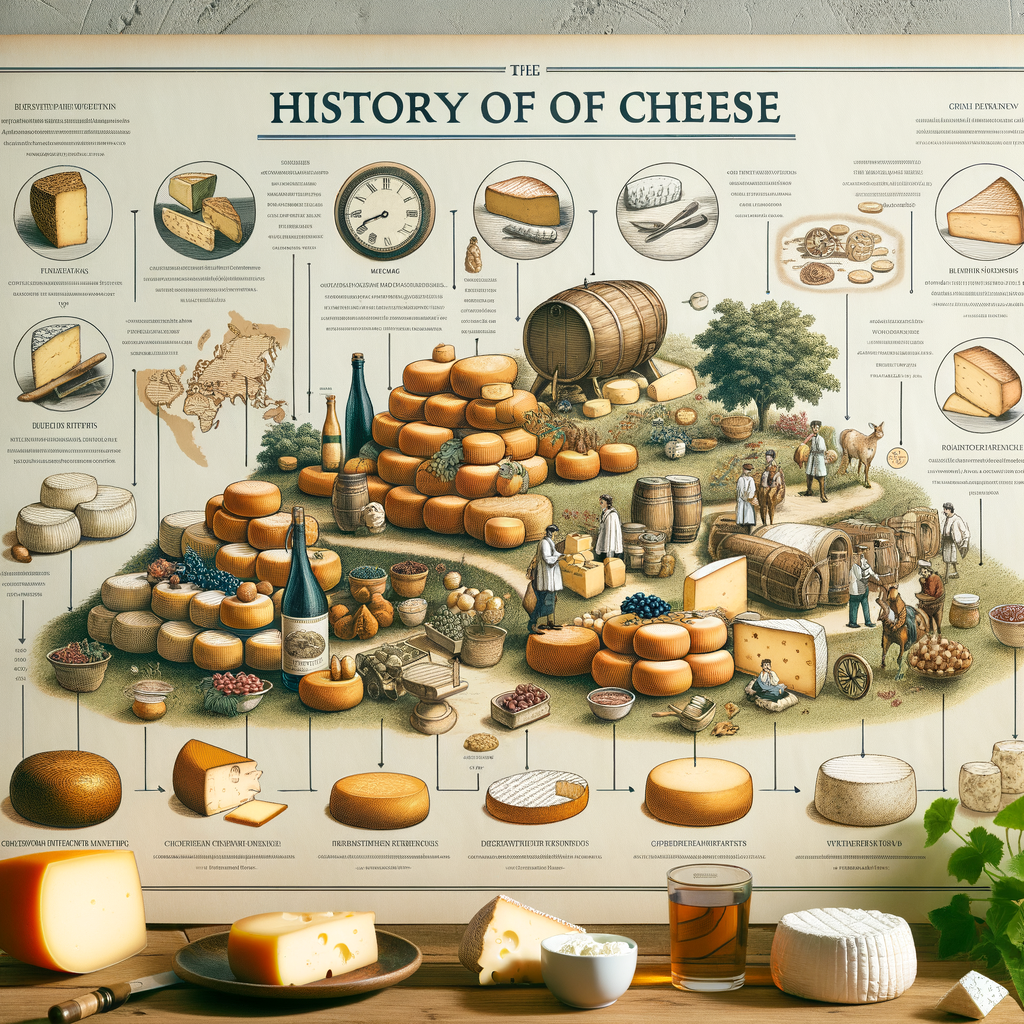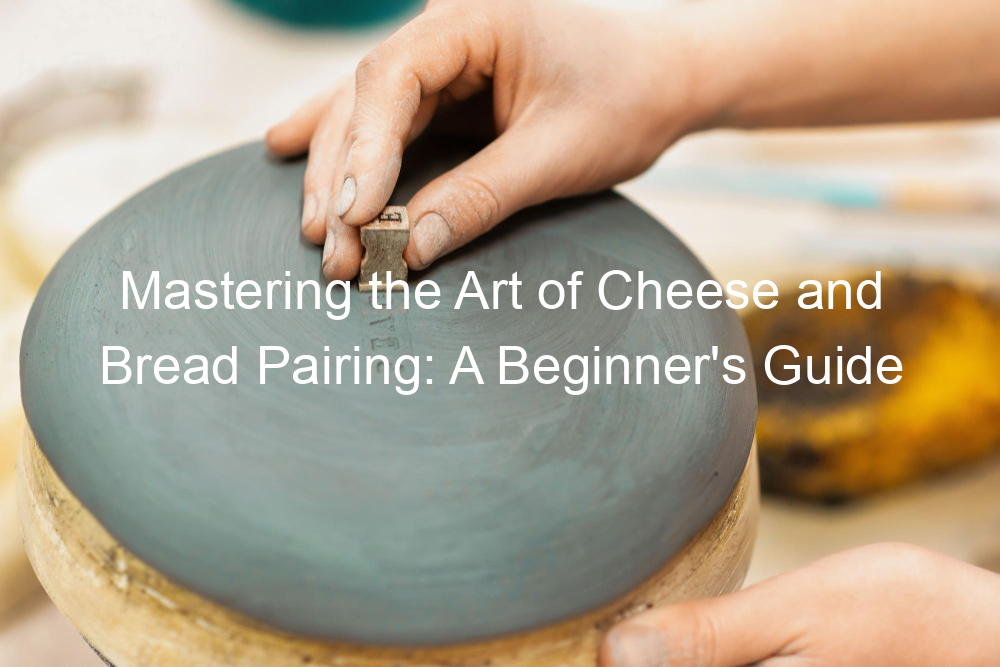
Introduction: A Brief Overview of Cheese History
For centuries, cheese has been a staple food in many cultures around the world. Its rich history is as diverse as the varieties of cheese we enjoy today. This article will delve into the fascinating journey of cheese, from its ancient origins to its role in different cultures and the evolution of cheese production techniques.
-
- The ancient origins of cheese
Cheese is believed to have originated around 8000 BC around the time when sheep were first domesticated. The earliest evidence of cheese-making was found in the form of pottery sieves in Poland dating back to 5500 BC. It’s thought that cheese was discovered accidentally by storing milk in containers made from the stomachs of animals, which contain rennet, a natural enzyme that curdles milk.
-
- The role of cheese in different cultures throughout history
Cheese has played a significant role in various cultures throughout history. In ancient Egypt, cheese was a regular part of the diet and was also used in religious rituals. The Romans were the first to introduce cheese-making as a trade, and they developed techniques for aging cheese and creating different varieties. In medieval Europe, monasteries became centers for cheese production and created many of the classic varieties we know today.
-
- The evolution of cheese production techniques
Over the centuries, cheese production techniques have evolved from simple methods used in homes to the industrial processes used today. The basic principle of cheese-making – curdling milk and then separating the solids from the whey – has remained the same. However, the introduction of pasteurization in the 19th century significantly improved the safety and consistency of cheese. Today, cheese production has become a sophisticated industry, with precise control over the types of bacteria and molds used, the aging process, and the addition of flavors and textures.
The Ancient Origins of Cheese
The history of cheese is as rich and varied as the many types of cheese we enjoy today. Let’s take a journey back in time to discover the ancient origins of cheese.
The First Cheese: Ancient Cheese Types and Their Origins
Believe it or not, the art of cheese making dates back thousands of years. Let’s explore the early days of cheese production and how it spread across the globe.
-
- Early cheese production in the Middle East
The earliest evidence of cheese production dates back to 8000 BCE in the Middle East. Archaeologists have found pottery shards with traces of cheese fats in them, suggesting that our ancestors were making cheese even then. This early cheese was likely a simple, fresh cheese, similar to what we know today as cottage cheese or feta. Wikipedia provides an in-depth look at the history of cheese.
-
- The spread of cheese-making to Europe
From the Middle East, the art of cheese making spread to Europe. By the time of the Roman Empire, cheese had become a staple food item. The Romans were the first civilization to master the art of aging cheese to improve its flavor and texture. They even had a separate kitchen, called a caseale, solely for cheese production. This spread of cheese-making across Europe laid the foundation for many of the cheese varieties we enjoy today.
So, the next time you enjoy a slice of cheese, remember that you’re partaking in a tradition that’s thousands of years old. The ancient origins of cheese are a testament to its timeless appeal and enduring popularity.
The Role of Cheese in Ancient Civilizations
Cheese has played a significant role in the history of several ancient civilizations. Let’s explore the importance of cheese in Ancient Egypt, Greece, and Rome.
-
- Cheese in Ancient Egypt
The ancient Egyptians had a profound appreciation for cheese. As early as 2000 BC, they had already mastered the art of cheese-making. Historical evidence shows that cheese was a staple food in their diet and was often used in religious rituals. Cheese was also used as a form of currency, and it was common for workers to be paid in cheese for their labor. The Egyptians even had a goddess of beer and cheese, named Tenenet.
-
- The importance of cheese in Ancient Greece and Rome
In Ancient Greece and Rome, cheese was considered a luxury food. It was a symbol of wealth and status, and was often served at feasts and celebrations. The Greeks believed that cheese was a gift from the gods, and it was often used in religious ceremonies. Historical records show that the Romans were the first to age cheese, creating a variety of flavors and textures. They even had a separate kitchen, called a caseale, solely for cheese production. This demonstrates the high regard they had for cheese.
As we can see, cheese has not only been a source of nourishment but also a significant part of cultural and religious practices in ancient civilizations. The love for cheese has indeed stood the test of time.
The Middle Ages: A Turning Point in Cheese History
The Middle Ages, a period spanning from the 5th to the 15th century, marked a significant turning point in the history of cheese. This era saw the rise of monastic cheese production, which played a crucial role in the development and diversification of cheese types.
The Rise of Monastic Cheese Production
During the Middle Ages, monasteries became the epicenter of cheese production. The monks, with their dedication to craftsmanship and their access to diverse resources, played a pivotal role in the evolution of cheese.
-
- The role of monasteries in the development of new cheese types
Monasteries were not just places of worship; they were also centers of learning and innovation. The monks experimented with different cheese-making techniques and ingredients, leading to the creation of new cheese types. Their secluded lifestyle allowed them to perfect their craft, and their commitment to self-sufficiency led them to produce a variety of cheeses to sustain their communities. This innovation had a profound impact on the cheese-making industry, with many of the techniques and recipes developed during this time still in use today.
-
- Examples of traditional cheese types that originated in monasteries
Many of the cheese types we enjoy today have their roots in monastic production. For instance, the famous Swiss cheese, Gruyère, was first made by monks in the canton of Fribourg. Another example is Port Salut, a semi-soft cow’s milk cheese from France, which was first produced by Trappist monks. These cheeses, along with many others, are testament to the enduring influence of monastic cheese production.
The Middle Ages marked a significant turning point in cheese history, with monasteries playing a key role in the development and diversification of cheese types. The legacy of this period continues to influence the cheese-making industry today.
The Impact of Trade and Exploration on Cheese Diversity
Trade and exploration have played a significant role in the diversity of cheese we enjoy today. As people traveled and traded, they introduced new types of cheese and innovative cheese-making techniques. This resulted in an explosion of cheese diversity that continues to evolve.
-
- The introduction of new cheese types through trade routes
Trade routes have been instrumental in spreading cheese diversity. As traders moved from place to place, they brought with them their local cheeses. This led to the introduction of new cheese types in different regions. For instance, the famous Cheddar cheese from England was introduced to many parts of the world through trade routes. This not only increased the variety of cheese available but also influenced local cheese-making traditions.
-
- The discovery of new cheese-making techniques and ingredients
Exploration also led to the discovery of new cheese-making techniques and ingredients. Travelers and explorers often came across unique methods of cheese production in the regions they visited. They then brought these techniques back to their homelands, further diversifying the cheese-making process. For example, the use of different types of molds in cheese production was a discovery made possible through exploration. Similarly, the use of various milks, such as cow, goat, and sheep, in cheese-making was a result of trade and exploration.
The diversity of cheese we enjoy today is a testament to the power of trade and exploration. It’s a delicious reminder of our shared history and the interconnectedness of our world.
The Modern Era: Industrialization and the Cheese Industry
As we delve into the modern era, we witness a significant shift in cheese production. The industrial revolution played a pivotal role in shaping the cheese industry as we know it today.
The Industrial Revolution and Cheese Production
The industrial revolution, a period of rapid industrial growth from the mid-18th to mid-19th century, had a profound impact on various sectors, including the cheese industry.
-
- The impact of industrialization on cheese production methods
Industrialization introduced new technologies and processes in cheese production. Prior to this, cheese was primarily made by hand, a labor-intensive and time-consuming process. The advent of industrialization brought about mechanization, leading to increased efficiency and volume in cheese production. Machines could now perform tasks such as curdling, cutting, and pressing, significantly reducing the time and effort required.
-
- The rise of factory-made cheese
With the onset of industrialization, the cheese-making process was no longer confined to small farms and households. Large factories began to emerge, capable of producing cheese on a massive scale. This led to the rise of factory-made cheese, which was more uniform in quality and cheaper to produce. By the late 19th century, factory-made cheese had become a common sight in grocery stores.
Industrialization not only changed the way cheese was produced but also how it was consumed. The availability of cheap, factory-made cheese made it accessible to a wider audience, leading to a surge in its popularity.
However, this industrial boom also had its drawbacks. The emphasis on mass production often led to a compromise on the quality and diversity of cheese. The unique flavors and textures of traditional, hand-made cheese were often lost in the process.
Despite these challenges, the cheese industry continued to evolve, adapting to the changing tastes and preferences of consumers. The next chapter in the cheese history is marked by a resurgence of artisanal cheese making, a trend that continues to this day.
Contemporary Cheese: The Resurgence of Artisanal Cheese Making
In the modern era, there has been a significant shift in the cheese industry. A growing number of cheese lovers and producers are turning their backs on mass-produced, factory-made cheeses, embracing instead the traditional, artisanal cheese types. This resurgence of artisanal cheese making is not just a trend, but a testament to the enduring appeal of quality, handcrafted cheeses.
-
- The modern trend towards traditional, artisanal cheese types
Artisanal cheese, made with traditional methods and often on a small scale, is experiencing a renaissance. This trend is driven by consumers’ increasing desire for authenticity, quality, and flavor in their food. Artisanal cheeses, with their unique textures and complex flavors, offer a richness and depth that factory-made cheeses often lack. According to a Wikipedia article, artisanal food, including cheese, is made in a traditional or non-mechanized way. This method of production contributes to the high quality and unique flavor profiles of these cheeses.
-
- Case studies of successful artisanal cheese makers
Many artisanal cheese makers have found success in this burgeoning market. For example, the Vermont Creamery has been producing award-winning artisanal cheeses for over 30 years. Their cheeses, made using traditional European methods, have won numerous awards and have helped to elevate the status of American artisanal cheese on the global stage.
Another successful case is the Cypress Grove Chevre, a California-based cheese maker specializing in goat cheese. Their innovative and high-quality cheeses have earned them a loyal following and have helped to popularize goat cheese in the United States.
These case studies illustrate the potential for success in the artisanal cheese industry. They also highlight the importance of quality, tradition, and innovation in creating cheeses that resonate with today’s discerning consumers.
Conclusion: The Ongoing Journey of Cheese History
As we conclude our exploration of the rich and diverse history of cheese, it’s important to reflect on the journey we’ve taken. From the ancient origins to the modern era, cheese has played a significant role in human culture and cuisine. But the story of cheese is far from over. Let’s delve into the importance of understanding cheese origins and the future of cheese.
-
- The Importance of Understanding Cheese Origins
Understanding the origins of cheese is not just about appreciating its rich history. It’s about recognizing the skill, dedication, and innovation that went into its creation. The process of cheese making has evolved over thousands of years, shaped by different cultures and civilizations. This knowledge can deepen our appreciation for cheese, enhancing the experience of tasting and savoring it. Moreover, by understanding its origins, we can better appreciate the diversity of cheese, each type carrying a unique story of its own.
-
- The Future of Cheese: Preserving Tradition While Embracing Innovation
As we look to the future, the world of cheese continues to evolve. While we must preserve the traditional methods and recipes that have been passed down through generations, there is also room for innovation. New techniques and technologies are constantly being developed, allowing for the creation of new cheese varieties and improving the quality of existing ones. The future of cheese is a balance between preserving tradition and embracing change, ensuring that this beloved food continues to delight and surprise us for generations to come.
The history of cheese is a fascinating journey that continues to evolve. By understanding its origins and looking towards its future, we can fully appreciate the art of cheese making. Whether you’re a cheese lover, a home cheese maker, or simply a curious reader, we hope this exploration of cheese history has been as enriching for you as it has been for us.






